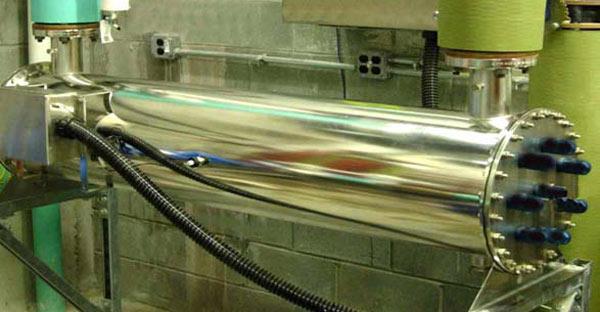
Water reuse is, and will continue to be one of the biggest considerations for companies all over the world in the battle against water scarcity. By reusing process water, grey water, and wastewater, buildings and facilities will reduce their demand for raw water from surface and groundwater sources and reducing the associated costs of supplying raw water and treating raw water before use. One of the disinfection methods to treat this water is using a UV treatment for water reuse applications.
Reusing water can be more difficult in certain applications, namely those that demand water that is free of microbes like bacteria. Treatment to such a level typically demands a tertiary treatment stage. This treatment would be accomplished by way of disinfection, essentially killing any harmful pathogenic organisms by rupturing their cell wall or destroying proteins or mutating DNA to prevent them from proper functioning and reproducing.
Disinfection by ultraviolet radiation has been growing in popularity over the past several decades for its lack of chemical additives and compact sizing, making it an excellent choice for integration into pre-existing systems.
You may be wondering how UV treatment for water reuse applications is designed and engineered.
Therefore, this article will touch on key aspects of design characteristics of a UV disinfection system and why one design may be more efficient for a particular application.
Design Characteristics
UV treatment systems are relatively simple — which is why they are so compact — and only consist of a few key components: lamps, a SS reactor vessel, sensors and a power module.
Lamp Type
Ultraviolet disinfection lamps are characterized by two things: pressure and output. The lamps are produced with those two properties at either a high or low setting. There are three types of lamps used in UV disinfection systems.
Low Pressure/Low Output: The most energy efficient lamps. These are best for lower flow applications that wish to use less energy during operation. Their lower output means it takes more lamps to produce an equal output to that of a more powerful lamp, necessitating more space in the facility.
Low Pressure/High Output: Mid-range lamps in terms of energy efficiency and germicidal effectiveness. Optimal for higher flow systems that also seek improved energy efficiency. They have a smaller footprint than LPLO lamps for treating a similar volume of water, but is larger than MP lamps.
Medium Pressure: The most powerful and effective lamps. If the facility can handle the power draw of these lamps, they are capable of handling high flow systems with a smaller footprint than LPLO or LPHO lamps. However, they also have shorter operating lives than low pressure lamps.
Reactor
This component is what contains the lamps and where the water to be disinfected, flows through. There are two main reactor types: open and closed. Open systems are constructed as channels in the ground that are open to the atmosphere and the UV lamps are lowered into this constructed channel. Closed systems are sealed on all sides with the UV lamps retained within. Many closed systems are built into pipe like structures that can be added directly to a piping system either inline, U-shaped, or S-shaped. Open systems are larger, but also offer easier access for maintenance while closed systems are more compact, but need to be shut down and taken apart for maintenance, which can mean longer down time.
Lamp Layout
Within the reactor, the UV lamps can be oriented parallel or perpendicular to the effluent flow. By the nature of their design, closed systems will usually position the lamps parallel to flow, but it can be either for open channel. Parallel lamps would lie horizontally in the channel, meaning the bed could be shallower, but the area of disinfection is limited to the length of the lamps. These systems also take more time to change out lamps as the entire configuration needs to be lifted from the channel. Perpendicular lamps are stood up vertically in a much deeper channel. This increases the cross sectional area of disinfection, and multiple modules can be placed next to and downstream of one another to increase the effective reaction time of disinfection. In addition, lamps in this configuration can simply be pulled up individually for replacement instead of the entire module, resulting in much faster replacement times.
UV and UVT sensors
A vital component for monitoring the effectiveness of the system over time, that will help gauge when maintenance needs to be done. The UV sensor measures the intensity of the lamp output to ensure proper dosing. UVT sensors measure transmittance, which is essentially how effectively UV light is penetrating the solution. If transmittance decreases, it could be an indication of turbid water or lamp fouling. There isn’t much variation in options for these system components other than the vendor.
Do you want to learn more about choosing UV treatment for water reuse, wastewater or process water for disinfection? Contact the water treatment experts at Genesis Water Technologies, Inc. at 1-877-267-3699 or reach out to us via email at customersupport@genesiswatertech.com for more information.

